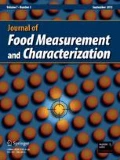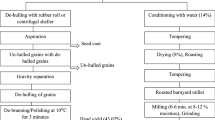Abstract
Tea is commonly known to be rich in certain micro- and macroelements. The objective of the study was to evaluate and compare the percentage transfer to the infusion of some essential elements (Ca, K, F, Mg, Na, and P) and determine concentrations of macroelements available in the bagged and leaf black teas of the same brand as well as to assess whether drinking tea could contribute to the daily nutritional mineral requirements of the consumers. The results showed that regardless of the tea type, the most abundant elements in both dry teas and infusions were K and Ca, while F concentrations were the lowest. The PCCA showed that content of elements in dry teas was high while in infusions low. The content of elements was similar in the dry bagged and leaf teas of the same brand, except for F which content was higher in the bagged teas (the U Mann–Whitney test, p < 0.05). Whereas, in case of the infusions, bagged teas contained higher amounts of Ca, F, K, Mg and Na (the U Mann–Whitney test, p < 0.05). The solubility of F, K and Na was high, while in case of Ca, Mg and P moderate. For K, Mg and Na the percentage release from dry tea to the infusion was significantly higher in the bagged than in leaf teas (the U Mann–Whitney test, p < 0.05). The results showed that the tea consumption may substantially contribute to F and Na daily intake (up to 37 and 77.5% of human dietary reference intake, respectively).

Similar content being viewed by others
References
M. Yemane, B.S. Chandravanshi, T. Wondimu, Food Chem. 107, 1236–1243 (2008)
L. Yao, X. Liu, Y. Jiang, N. Caffin, B. D’Arcy, R. Singanusong, N. Datta, Y. Xu, Food Chem. 94, 115–122 (2006)
C.S. Yang, J.M. Landau, J. Nutr. 130, 2409–2412 (2000)
J. Malik, J. Szakova, O. Drabek, J. Balik, L. Kokoska, Food Chem. 111, 520–525 (2008)
J. Olivier, E.A. Symington, C.Z. Jonker, I.T. Rampedi, T.S. van Eeden, S. Afr. J. Sci. 108, 1–7 (2012)
A. Szymczycha-Madeja, M. Welna, P. Pohl, Trends Analyt. Chem. 35, 165–181 (2012)
G. Chen, C. Yang, S. Lee, C. Wu, J.T.C. Tzen, J. Food Drug Anal. 22, 303–309 (2014)
D. Gebretsadik, B. Chandravanshi, B. Chem. Soc. Ethiopia 24, 339–349 (2010)
A. Koblar, G. Tavčar, M. Ponikvar-Svet, Food Chem. 130, 286–290 (2012)
M.H. Wong, K.F. Fung, H.P. Carr, Toxicol Lett. 137, 111–120 (2003)
A. Hicks, AU J. Technol. 12, 251–264 (2000)
D. Ramdani, A.S. Chaudhry, C.J. Seal, J. Agric. Food Chem. 61, 4961–4967 (2013)
L. Chan, A. Mehra, S. Saikat, P. Lynch, Food Res. Int. 51, 564–570 (2013)
J. Brzezicha-Cirocka, M. Grembecka, P. Szefer, Eur. Food Res. Technol. 242, 383–389 (2016)
S.M.T. Gharibzahedi, S.M. Jafari, Trends Food Sci. Technol. 62, 119–132 (2017)
A. Pękal, M. Biesaga, K. Pyrzynska, Food Sci. Biotechnol 22, 925–930 (2013)
I.A. Hakim, U.M. Weisgerber, R.B. Harris, D. Balentine, C.A.J. van-Mierlo, I. Paetau-Robinson, Nutr. Res. 20, 1715–1724 (2000)
M. Salahinejad, F. Aflaki, Biol. Trace Elem. Res. 134, 109–117 (2010)
M. Dambiec, L. Polechońska, A. Klink, J. Food Comp. Anal. 31, 62–66 (2013)
J. Cao, S.F. Luo, J.W. Liu, Y. Li, Food Chem. 88, 233–236 (2004)
W. Horowitz, AOAC Official Methods of Analysis, 17th edn. (Association of Official Analytical Chemists International, Gaithersburg, 2000), pp. 51–56
A. Stanisz, Statistics Course with STATISTICA PL Based on Medicine Example, 3rd edn. (StatSoft Polska, Kraków, 2006), pp. 369–381
R.R. Sokal, F.J. Rohfl, Biometry: The Principles and Practice of Statistics in Biological Research, 4th edn. (W.H. Freeman, New York, 2012), pp. 220–228
P. Legendre, L. Legendre, Numerical Ecology, Developments in Environmental Modeling, 2nd edn. (Elsevier, Amsterdam, 1998), pp. 391–423
Inc StatSoft, 2009. STATISTICA (Data Analysis Software System), Version 9.0. http://www.statsoft.com
A. Kumar, A.G.C. Nair, A.V.R. Reddy, A.N. Garg, Food Chem. 89, 441–448 (2005)
D. Desideri, M.A. Meli, C. Roselli, L. Feduzi, Microchem. J. 98, 186–189 (2011)
R.N. Gallaher, K. Gallaher, A.J. Marshall, A.C. Marshall, J. Food Comp. Anal. 19, 53–57 (2006)
L. Fishbein, Regul. Toxicol. Pharm. 39, 67–80 (2004)
S.A. Atkinson, R. Costello, J.M. Donohue, Overview of global dietary calcium and magnesium intakes and allowances, Calcium and Magnesium in Drinking-Water: Public Health Significance, ed. by J. Cotruvo, J. Bartram (World Health Organization, Geneva, 2009)
H.P. Carr, E. Lombi, H. Küpper, S.P. Mcgrath, M.H. Wong, Agronomie 23, 705–710 (2003)
WHO, Guideline: Sodium Intake for Adults and Children (World Health Organization, Geneva, 2003), pp. 11–14
M.T. Soomro, E. Zahir, S. Mohiuddin, A.N. Khan, I.I. Naqvi, Pak. J. Biol. Sci. 11, 285–289 (2008)
WHO, Guideline: Potassium Intake for Adults and Children (World Health Organization, Geneva, 2012), pp. 10–12
C.N. Ong, Minerals from Drinking Water: Bioavailability for Various World Populations and Health Implications. Rolling Revision of the WHO Guidelines for Drinking-Water Quality (World Health Organization, Geneva, 2004)
K. Kalantar-Zadeh, L. Gutekunst, R. Mehrotra, C.P. Kovesdy, R. Bross, C.S. Shinaberger, N. Noori, R. Hirschberg, D. Benner, A.R. Nissenson, J.D. Kopple, Clin. J. Am. Soc. Nephrol. 5, 519–530 (2010)
National Research Council, Dietary Reference Intakes for Calcium, Phosphorus, Magnesium, Vitamin D, and Fluoride (The National Academies Press, Washington, 1997), pp. 146–190
WHO; Fluoride in Drinking-Water. Background Document for Development of WHO Guidelines for Drinking-Water Quality (World Health Organization, Geneva, 2004), pp. 29–35
W.S. Shu, Z.Q. Zhang, C.Y. Lan, M.H. Wong, Chemosphere 52, 1475–1482 (2003)
E. Malinowska, I. Inkielewicz, W. Czarnowski, P. Szefer, Food Chem. Toxicol 46, 1055–1061 (2008)
Institute of Medicine, Food and Nutrition Board. Dietary Reference Intakes (DRIs): Recommended Dietary Allowances and Adequate Intakes. Vitamins (National Academies, Washington, 2011), pp. 2–6
A. Mossion, M. Potin-Gautier, S. Delerue, I. Le Hecho, P. Behra, Food Chem. 106, 1467–1475 (2008)
M. Długaszek, Ż. Kurpiewska, J. Mierczyk, Eur. Food Res. Technol. 241, 289–293 (2015)
Author information
Authors and Affiliations
Corresponding author
Ethics declarations
Conflict of interest
The authors declare that they have no conflict of interest.
Rights and permissions
About this article
Cite this article
Klink, A., Dambiec, M., Polechońska, L. et al. Evaluation of macroelements and fluorine in leaf and bagged black teas. Food Measure 12, 488–496 (2018). https://doi.org/10.1007/s11694-017-9662-7
Received:
Accepted:
Published:
Issue Date:
DOI: https://doi.org/10.1007/s11694-017-9662-7




